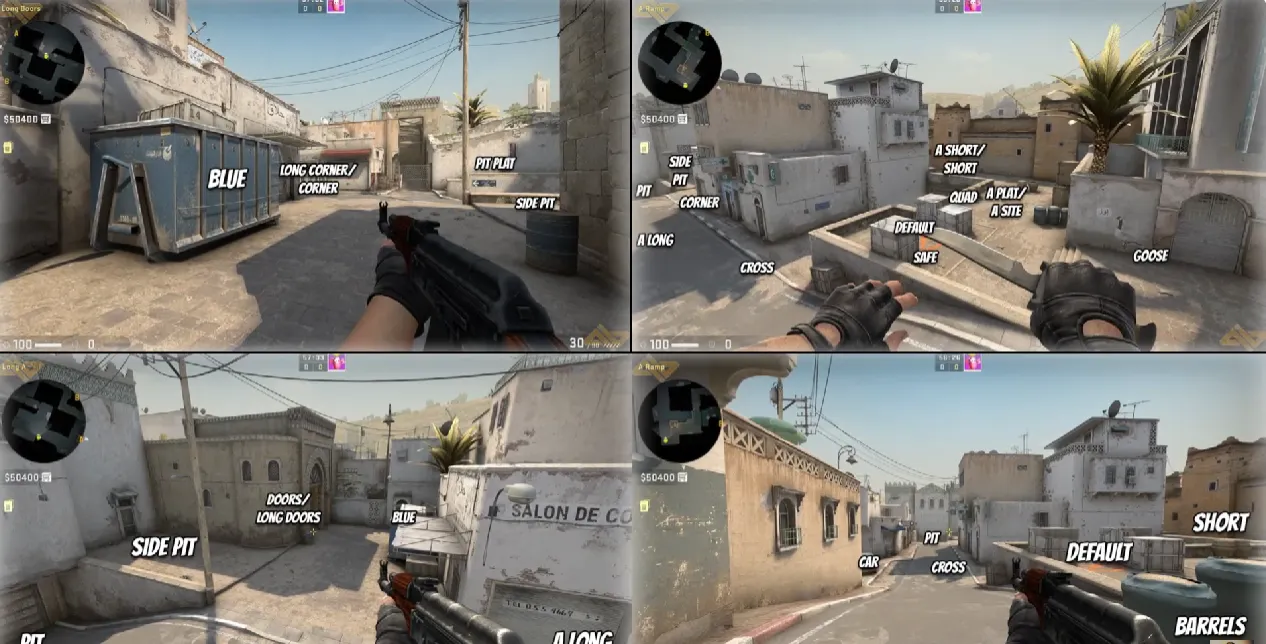All Dust 2 Map Callouts in CS2

If Counter-Strike 2 had to be defined by a single map, it’d be Dust 2. Based in Morocco, Dust 2 is undoubtedly CS2’s most iconic map, one that is instantly recognizable by any PC gamer, Counter-Strike player or not. Since debuting in the early days of the game, Dust 2 has remained the heart of the franchise, offering the perfect balance of simplicity and strategy. In CS2, the map has been revamped with visual changes, making the map look more appealing without changing its classic flow that every player knows and loves. To certify yourself as a “real” Counter-Strike player, it’s essential to master all Dust 2 callouts, so you don’t look like a headless chicken while playing on the game’s most popular map. Here’s everything you need to know about Dust 2 and its spots.
Overview of Dust 2 in CS2
Despite being designed two decades ago, Dust 2 has always remained as the gold standard of Counter-Strike maps and their designs. In CS2, in particular, the map feels better than it ever has been.
The map has maintained its familiar three-lane layout, with heavy emphasis on the A Site, B Site, and massive Mid area. This keeps gameplay straightforward, making it a popular pick for casual players who just want to focus on shooting heads.
One of the most notable changes is the addition of Valve’s Source 2 engine, where the update introduced major visual enhancements. Visibility, such as shadows, have been improved, and lighting in areas such as Lower Tunnels have been polished. Texture details are also added across every nook and cranny on the CS2 map, making Dust 2 look modern.
Apart from an additional wall on the “Suicide” area at the Terrorist Spawn, there were no tweaks or new features on Dust 2. The changes were primarily focused on visuals and aesthetics. The map structure remains familiar for any veteran player looking to return to the game.
What Are Callouts and Why They Matter
In Counter-Strike, the term “callouts” refers to specific names players use to identify and describe locations on a map. Callouts are essential for communication, allowing players to share information with teammates quickly and precisely with minimal time. If an enemy was spotted somewhere on the map, players can relay their positions through callouts so everyone else on the team can get on the same page.

On Dust 2, knowing your callouts will drastically improve team strategy and map control. Instead of saying, “he’s over there,” or “he’s behind the box,” you can say “one Mid Doors,” or “AWP in Pit.” This instantly gives teammates actionable information, instead of keeping them in the dark or confused about where to look at.
This kind of clarity speeds up reactions and strengthens coordination across the team. Even small callouts, like differentiating “A Short” from “Catwalk,” can shift the outcome of a round, so make sure your callouts are as accurate as possible!
Full List of Dust 2 Callouts
Now that we’ve understood the importance of Dust 2 map callouts, let’s get into each of them. Here is a list of all Dust 2 callouts you need to know, covering different positions and locations:
| Position | Description |
|---|---|
| Barrels | The two barrels are located next to the A Site, where players can peek into both Long A and Short A. |
| Ramp | A ramp that allows players access to get up to the site itself. A great position for players to hide behind. |
| Goose | The area behind the A Site, next to the wall. It was named after Gooseman, the developer of CS. |
| Gandalf | Gandalf, also known as Ninja, is a small corner behind boxes where players can sneakily hide. |
| Boost | The area under the bridge, where players can go from CT Spawn to A Short by climbing up boxes. |
| Elevator | The area below the A Site, where players can boost each other to get to the bomb site. |
| A Short | The area that connects Mid to the A Site. |
| A Long | The long lane that leads players to the A Site. |
| Car (A) | A car is located on the side of A Long. Players can hide behind this car for cover. |
| Long Corner | The corner where CTs and Ts make contact when fighting for the area. |
| Pit | A large pit at the end of A Long, where players can hide and play post-plant positions from. |
| Blue | The corner behind a large, blue container located in the A Long area. |
| Long Doors | The two doors that transition players from T Spawn to A Long. Often a focal contention point. |
| Top Mid | The upper area of Mid, in front of T Spawn. |
| Green | A corner where players can hide at the top side of Mid. There is a green curtain. |
| Mid | The general middle area of the map, connecting to Tunnels, A Short, and Mid Doors. |
| Catwalk | The pathway that connects Mid to A Short. |
| Xbox | A large box located in the center of Mid. Players can jump on top to reach the Catwalk. |
| Mid Doors | The large double-door separating Mid from CT Mid. A crucial point of contention. |
| CT Mid | The middle area that is right next to CT Spawn. |
| CT Spawn | The area where CT players start the round from. |
| Upper Tunnels | The upper half of the Tunnels area gives players direct access to the B Site. |
| Lower Tunnels | The lower half of the Tunnels area, giving players access to Upper Tunnels and Mid. |
| B Site | The general area on the B Site where Terrorists can plant the bomb down. |
| Car (B) | A car is located in the corner of the B Site area, which can provide cover for players. |
| Back Plat | Another corner on the opposite of the Car, where players can hide behind. A box is conveniently located there for cover. |
| Box | A large box with a green mat on top. A great position for site holds or post-plants. |
| B Doors | The double door allows access into the B Site. |
| Fence | A small corner where players can hide behind, anticipating rushes from Upper Tunnels. |
| Window | A gap between the wall separating the B Site, allowing access into the bomb site. |
| T Spawn | The area where T players start the round from. |
| Outside Long | The area separating T Spawn and A Long Doors. |
| Suicide | A tight corridor where T players can run down to Mid. Very vulnerable to snipers in the early round. |
| Outside Tunnels | The area separating T Spawn and Upper Tunnels. |
Learning and Practicing Dust 2 Callouts
Remember, map learning and mastering Dust 2 CS2 callouts won’t happen overnight. You’ll have to play the map multiple times, and practice callouts with repetition and consistent practice.
The best way to get a good feel is to explore the map in a private lobby. Simply walk around the map, while checking the minimap to remember the callout names. It also helps to say the callouts out loud as you continue walking around to reinforce your memory through simple repetition. Again, you won’t memorize everything in one go, so you’ll need a couple of days to master them.

There are also useful workshop training maps that are free to download. These tactical maps are specifically made for players to practice on. Instead of only learning callouts, you can also pick up a few grenade lineups you can use in your matchmaking games.
Another effective way to remember your callouts is to play with friends who understand the map. You can practice these callouts with them, while also listening to them communicating back. This two-way communication will help you memorize callouts quickly. Call out everything you see, even if it feels redundant, so you can build the habit of constant communication while playing.
Simply put, the more you play, the more natural memorizing callouts on Dust 2 becomes. Eventually, you won’t have to think twice about where “Xbox” or “A Long” is. Your instincts and map sense will kick in, and you’ll mention the callout without thinking.
How Callouts Improve Competitive Play
In competitive Counter-Strike, shooting is only half of the game. The other half comes from teamplay, and communication is the backbone of it. Clear and accurate callouts can mean the difference between winning and losing a game.
When everyone on the team is communicating, such as giving callouts and plans, the team strategy becomes infinitely better, and coordination becomes natural. You’ll know exactly where your teammates and enemies are, allowing you to plan out your next move and rotation with confidence.
For example, if there are three enemies alive, and one teammate calls out “two A Long,” the entire team has a good idea of where to rotate, and that one enemy remains missing on the map. With this communication, the team can make informed moves and watch angles accordingly.
Remember, effective callouts don’t just provide others with intel. Team synergy is being built in the process, where everyone is moving on the same page. When proper information is relayed, teammates can play their roles with confidence, and over time, these habits create trust among each other in the long run.
Professional teams don’t only outshoot their opponents – they also out-communicate them. Moving properly as a unit allows for efficient trades and utility usage that increases the odds of winning any round, even with a low buy.
Tips for Mastering Map Control
To win rounds on Dust 2 and rank up, understanding and gaining map control is the key to success, especially in competitive matches. Dust 2’s layout is straightforward, placing heavy emphasis on three lanes: A Site, B Site, and Mid.

In general, controlling Mid is often the best way to win rounds on Dust 2, as it opens paths to both A and B sites, especially the CT Spawn area. However, breaking through the Mid Doors can be quite tricky if done without utility. It’s vital to prepare smoke and flashbang lineups to break through the defense and cut off vision.
The Upper and Lower Tunnels are also a crucial area to fight for. Both sides love sending players to fight for the area, as it covers a large part of the access to the B Site. If Counter-Terrorists can take full control, they can bet that Terrorists are around the A side of the map.
When hitting the A Site, it is often best to pool resources into an “A Split,” where members attack from both Short and Long. Going all-in on one side can be a mistake due to how tight the areas are.
Your Final Step to Mastering Dust 2 in CS2
Mastering the Dust 2 callouts in CS2 is easily one of the best ways to improve your gameplay. Most often, it’s even become a bare minimum to know every callout on the most popular map in the game. You’ll have to learn the names of every corner, chokepoint, and box on this legendary CS2 map.
Learning these callouts will allow you to become a more impactful teammate through communication, ensuring your team receives accurate information. Keep practicing your Dust 2 map callouts, review them after matches, and make clear and concise callouts a natural habit.
If you keep playing on the map, you’ll realize that such callouts have become muscle memory. Your map awareness and team strategy will also improve, so make sure you grind out those matches!
FAQ
What are the main callouts on Dust 2 in CS2?
The essential callouts Dust 2 offers are A Long, A Short, Tunnels, A Site, B Site, and CT Spawn. However, other callouts are also crucial for relaying accurate information to your teammates, as players could appear anywhere on the map.
How many callouts are there on Dust 2?
There are around 30 to 40 callouts you should know, but there are more based on very specific locations. Overall, memorizing the main callouts should be enough for you to be a functional teammate in communicating.
What is the best way to learn Dust 2 callouts?
The best way to learn CS2 Dust 2 callouts is to study the table above, while also joining a private server and walking around the map. Explore the map and say the callouts out loud to drill it into your brain.
Are Dust 2 callouts different in CS2 compared to CS:GO?
No, most csgo dust 2 callouts remain the same from CS:GO to CS2. There were no major map changes in the transition, so almost all references and callouts did not change. There were only visual changes that did not affect gameplay.
Why are callouts important in competitive play?
Callouts are crucial in competitive play, as they ensure quick and accurate communication so teammates can react instantly and make informed decisions. It is your responsibility as a teammate to relay accurate callouts.
How can I practice Dust 2 callouts efficiently?
To practice your callouts, you can view a labeled map and memorize from there. However, the best way is to play more matches on the map and continuously give out callouts. That way, the callouts will become ingrained as muscle memory.
















